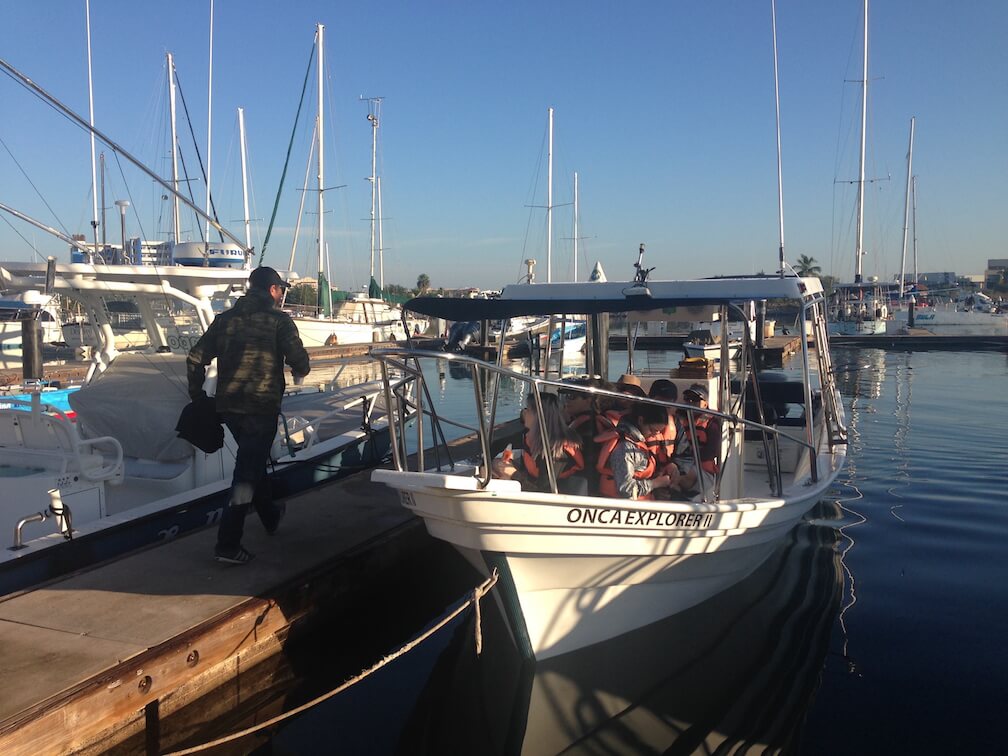Thursday, January 4, 2018: while a weather bomb is pummelling Quebec, I have an appointment at 7:30 in the morning with Oscar Guzon of Onca Explorations in Mazatlan, on the Pacific coast of Mexico. I have been living in this city for a week, having travelled 5,590 km from Pointe-au-Père in the Gaspé Peninsula. I connected with Oscar through my friend Christian Ramp of the Mingan Island Cetacean Study (MICS). Oscar founded a research station in 2006 modelled on the one operated by MICS, where he interned in the early 2000s as part of his marine science studies.
I leave my bike in his office and we set out in his car for the marina a few kilometres away, where his assistant Augustin and 15 or so tourists geared up for a whale-watching trip are waiting for us. It is particularly difficult to fund a research organization without the support of sponsors, volunteers and the whale-watching business. For today’s excursion, he’ll operate two boats (Mexican pangas) to accommodate his fifteen or so passengers and carry out his research.
We leave for the open sea after Oscar (in English) and Augustin (in Spanish) provide a succinct 30-minute rundown of their work and what awaits us at sea.
Pacific waters at this latitude are breeding grounds for humpback whales, which arrive there after spending the summer off the Canadian and US west coasts. Off the coast of Mazaltan, the waters are dotted with tiny islands that host breeding seabird colonies at other times of the year.
After barely travelling 3 or 4 nautical miles from shore, already we can see large spouts and tails in the air. Oscar, Augustin and I are the only ones that initially see them, since the tourists are not accustomed to watching whales and are more busy talking to each other or looking around the boat than scanning the horizon.
We observe our first pair of humpbacks at the same time as we see other small clusters of two or three individuals a little farther out. There are two breaching sessions that are difficult for me to take a picture of due to the distance, as well as a beautiful sequence of tail slapping and another one of pectoral slapping, the latter quite far away.
The humpbacks seem very active. However, their behaviour is quite different from what I am used to observing in the Gulf of St. Lawrence. The whales surface very dynamically and their trajectories are rather random, with long dive times and short breathing sequences. It is rather obvious that these whales are engaged in something other than feeding, which, in our waters, looks nothing like these observations.
According to Oscar, who studies this courting behaviour, the female will offer herself to the most seductive male, and especially not to the most aggressive one. He compares courting sessions to those of birds. The most experienced male will oust his competitors to offer the female his most alluring display and most convincing serenade.
The songs of courting humpbacks are very impressive according to Oscar, who uses a hydrophone to listen to them. Unfortunately, on this day of intense boating traffic, there was far too much noise to let us fully appreciate them. What impact does this noise have on the quality of the serenade? While we can only imagine, research is attempting to prove it.
All told, we observed a dozen or so humpbacks in this limited area in small groups of two or three individuals, under bright blue skies and with no wind. To end our trip, we approach the coast to observe about forty California sea lions basking in the sun on a tiny rocky island. The islet seems unable to accommodate any more and it looks as if the animals are rotating so that as many individuals as possible can take advantage of it. There is some jostling and scuffling given the small space and the proximity of individuals to one another.
Another extraordinary day in the world of these giants, who never cease to amaze us!

















